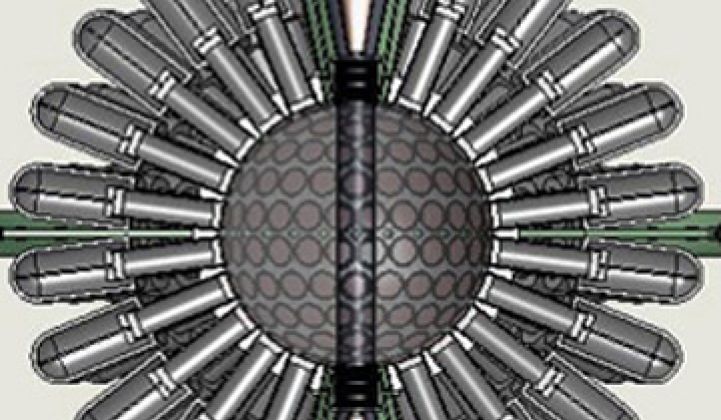General Fusion, a Canadian company that wants to harness fusion power, said it has raised $19.5 million from Bezos Expeditions (the personal VC fund of Jeff Bezos) in a second round that will help it create a demonstration of its technology.
General uses a technique called Magnetized Target Fusion (MTF). In this scenario, an electric current is generated in a conductive cavity containing lithium and a plasma. The electric current produces a magnetic field and the cavity is collapsed, which results in a massive temperature spike.
The lithium breaks down into helium and tritium. Tritium, an unstable form of hydrogen, is separated and then mixed with deuterium, another form of hydrogen. The two fuse and make helium, a reaction that releases energy that can be harvested. So in short, lithium, a fairly inexpensive and plentiful metal, gets converted to helium in a reaction that generates lots of power and leaves only a harmless gas as a byproduct. MTF has an advantage over other fusion techniques in that the plasma only has to stay at thermonuclear temperatures (150 million degrees Celsius) for a microsecond for a reaction to occur.
They also used to have a really cool picture of a dinosaur on their website. Today's picture is an artist's rendering of General's technology.
He or she who harnesses fusion power will likely get a Nobel Prize. It promises a source of cheap, clean, inexhaustible energy. Meltdowns like Fukushima can't occur because of the differences between fusion and fission. However, it's not easy. Fusion reactors have been a dream for decades. I asked Ernie Moniz in 2009 if we'd see fusion reactors anytime soon. Moniz, who runs MIT's Energy Initiative and once served as an Assistant Secretary of Energy, looked me up and down and said, "Not in your lifetime." Rear Admiral Frank Bowman, who runs the Nuclear Energy Institute, is also a skeptic.
Nearly all fusion projects must also grapple with long timelines and inevitable delays. The National Ignition Facility (NIF) at the Lawrence Livermore lab has devised a stadium-sized laser with 192 extremely-high powered beams. The beams can be focused onto a spot about a half a millimeter in diameter in a target chamber. If the energy can be delivered onto a fuel pellet made up of hydrogen isotopes, it can conceivably cause the atoms to fuse into a form of helium, and thereby deliver more power than the lasers consume.
A Laser Inertial Fusion Energy (LIFE) reactor could generate 1 to 2.5 gigawatts of thermal power with its 10- to 20-megawatt laser system. The NIF built its laser facility on time by 2009. A demonstration of a net energy gain from the process will come in 2012 (earlier 2011), but a full integration of how a plant might work may not occur until the mid-2020s.
Secretive Tri-Alpha Energy has raised a lot of money. It has released some papers, but no demo.
Back in early 2008, General's investors said that the company would provide data to show that fusion could be reasonably feasible in three to four years. Or in other words, now. Suffice it to say, this one could take longer.
New nuclear is a Pacific Northwest thing. Terrapower, which is creating a modular fission reactor that can run on thorium, came out of Intellectual Ventures, the think tank/patent mill created by former Microsoft chief scientist Nathan Myhrvold. Bill Gates in an investor. NuScale Power, which has a modular reactor and is working to getting a project on the books in Iowa, comes out of Corvallis, Oregon. Oregon State, in Corvallis, mints more nuclear scientists than any other U.S. university.



